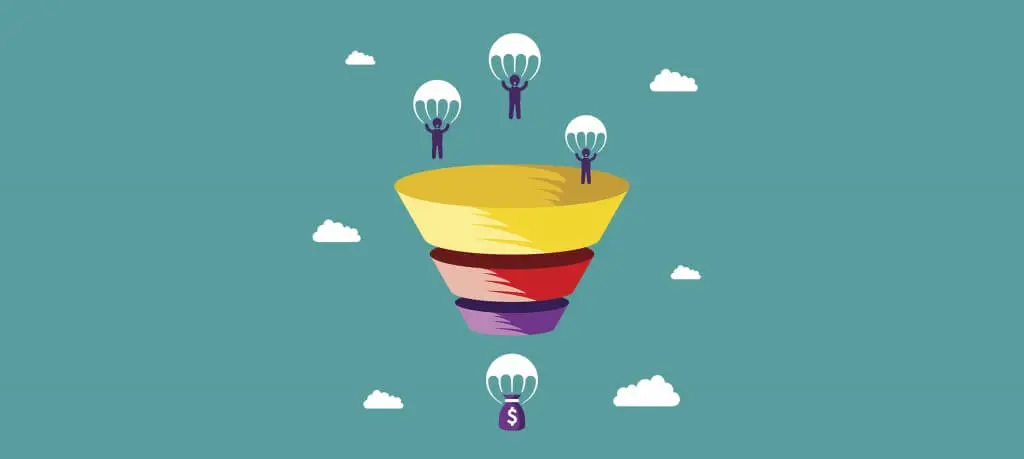What is a Sales Funnel?
A sales funnel definition is quite broad. It’s a visualization of a journey the potential customers take before purchasing what you offer. A funnel encompasses the whole way from the first interaction with a person to the moment of purchase. It helps marketers and managers realize what’s working well and what needs improvement in the sales strategy.

The funnel concept is relevant as most potential customers begin their journey at its top end. Yet, at the same time, only a tiny portion of these people end up at the bottom of the funnel, eventually making a purchase.
Many businesses are using this approach in their marketing or sales strategies. It has several key stages and is a great way to comprehensively reflect on the current state of things with customer engagement and the overall business performance of a business.
So what should you know about this concept to drive sales and bring more actual clients to your company? Keep reading — we got this!
Why Is the Sales Funnel Important?
The main argument for the importance of a sales funnel is that it’s a great way of visualizing the customer’s way from initial awareness to brand loyalty. Furthermore, this framework is easy to follow — hence, you can see the weak spots of your business strategy right away.
Plus, since a sales funnel is multi-stage, it helps companies allocate relevant tasks and implement practices working the most effectively at each step. Analyzing the performance of these separate stages is convenient and provides more in-depth insights needed to generate better sales and drive more clients.
Another reason why using the funnel is crucial for most businesses is that it helps communicate with customers. This way, companies learn, test, and eventually use different messaging and tones of voice to see what works best for their target audience.
It may not sound too obvious, but another aspect to consider is that it helps your company upsell much easier. Take email upselling as an example. Once a person makes a purchase, they receive an email with various products or services they can purchase afterward. It’s an effective way to sell complementary items, more expensive ones, or even those leading to another funnel.
Finally, a sales funnel helps you pick the right business model and marketing strategy. You study the drawbacks and success points of what you’ve already done. Moreover, you’ll then know what marketing tools to use to maximize your sales campaigns’ effectiveness and approaches to growing your clientele.
It’s a great thing to try if you don’t know how to drive customers better or what strategy to pick for your business. Sales funnels can easily show you what’s wrong and how you can improve on things.
How to Create a Sales Funnel for Your Business
Although the sales funnel stages are universal for each business, the approaches used to complete each of them are different. Therefore, to define them and know what strategy or tool to use at each step, you should do some preparations.
Below, you’ll see a checklist of steps that will help you set up an effective sales funnel from the first try.
Analyze the Audience’s Behavior
The primary purpose of a sales funnel is to communicate to people who would end up as your company’s customers. Try to learn as much as you can about your potential customers. Where do they click? How much time do they spend on a particular page? Do they usually scroll to the very bottom of a page? It’s a perfect way to define your buyer personas and make them more elaborate.
Grab the Attention of Your Target Audience
One of the best ways to define if your funnel works properly is to see if you can lead your potential customers into it. And how can you do it? Through content.
Start posting as many informative and engaging posts, newsletter templates, and articles as possible. To boost their effectiveness, add figures and helpful information. Infographics, research data, product videos, interviews, and so on will maximize your marketing campaigns and create a trusted, reputable brand.
Don’t be scared to spend some money on paid ads, but only on the most effective platforms for your business. Then, run some proper targeting, and you’re good to go!
Create a Landing Page
Where do your social media campaigns have to lead your target audience? Right, to your website or a product section. Hence, you’ll need to create a landing page and make it rock.
The primary purpose of leading customers to it is to motivate them to take the next step. Watch a demo, Find out more, download a free instruction — depending on your purposes and product type, choose a good call to action that will be an intermediary between getting to know your company or solution better and trying what you offer.
Creating a landing page is also crucial for every business — at least to give users an understanding of what your company is about and make sure it’s worth trusting your business. The more effort you put into creating a well-optimized, intuitive, and convenient landing page, the more potential customers you’ll likely get.
Create a Rockstar Email Campaign
Email marketing is still one of the most effective tools for promoting your business and services. As of 2022, one dollar you spend on it leads to approximately 4200% ROI. Impressive, right? That should be a convincing reason to try it.
Set up a stunning email newsletter. Do the A/B testing to see what formats work best for you. Try different types of content and lengths, and add the most relevant information that your potential customers want to learn. Do some research, gather focus groups, and do in-depth interviews.
Create an excellent visual outlook — prepare several style templates, but always consider your company’s color palette and designs. Don’t forget to add a clickable logo and a CTA. These elements will help you create a perfect newsletter template you can use to boost user engagement, your business value, and brand awareness.
Don’t Forget About Your Existing Customers
Always remember about your current clientele. Keep reaching out to them. It can be a simple thank-you note for the customers’ purchases, personal discounts, reminders to follow your business on social media, etc.
Customers appreciate that. Try reminding them about your existence — this way, you’ll always appear in their information field and motivate them to learn more about the latest updates, new products, and special offers.
These simple steps will help you set up an effective and engaging sales funnel for driving as many new customers as possible. Try them out to improve your marketing and business strategies — you’ll see the results pretty fast!
What Are the Sales Funnel Stages?
Now that you know what is a sales funnel and how to build an effective one, time to talk about its critical steps.
The moments of introducing your product and purchasing something are related to different lead funnel stages. The central concept behind it is the AIDA model: Awareness, Interest, Decision, and Action.
Don’t worry! We have all the sales funnel stages explained. Let’s find out more about them!
Awareness
It’s the first time users learn about your company and what you offer. You may receive this information from various sources: from word of mouth to social media ads. The way those people land into a funnel depends on what methods and tools you use.
It’s the time when you show your brand identity and how it responds to your target audience. At this stage, the most influential users are those who moved from awareness to interest. Try to figure out where these leads came from to see what channels were the most effective in the first step.
However, it’s not enough to just see your social media post or an ad to get into the funnel. If a user read the post or heard some information about your company from a friend is what counts more.
Interest
At this stage, users need to learn more about your product and see if yours is the best solution to fulfill their needs. People tend to do some competitor research before choosing the top option.
You may raise interest in your product by providing some extra value. It can be an outstanding support team, adding several additional features, or making your solution more customizable. Be creative and make something that stands out.
Decision
Once users see the grounds for considering your solution, they do more research — now, on the packages and pricing options. Be sure of the price segment you’re about to enter, and always pay attention to what prices your competitors set for a similar product.
Don’t be afraid to be a bit different — if you’re sure you can offer more, take your solution to a luxury segment, add a subscription, or offer some customizable features no other competitor has.
Action
The most decisive stage: you’ll finally see whether a person made a purchase. Even if it didn’t work, it doesn’t mean you lost those customers forever.
You still have the email list — make great use of it! You know now that email campaigns are pretty efficient, so why not try once again with a bit more effort? Eventually, it’ll pay you back well.
These sales funnel steps are uniform for every business model. Once you know what type of strategy and tools to apply to each of them, you will rock it.
How Sales Funnel Management Can Help
It’s essential to keep your funnel well-balanced. If it’s too sophisticated, it may seriously affect your business and lower the sales.
But no worries, though — there are some tips on proper sales funnel management that’ll help you keep it simple and successful.
Prioritize the Right Leads Over the Irrelevant Ones
If you’re trying to generate leads from people who have nothing to do with your product and possibly won’t be interested in it, it’ll just be a waste of time. So instead, focus on smaller yet more engaged target groups. In this case, you’ll get better responsiveness and loyalty from them in the future.
Ensure Proper Training
Management teams need to provide constant learning for their sales teams. Remember to provide training for people of all levels of expertise, from entry-level to seniors. In addition, it’s crucial to ensure bringing in the latest technology and practices to maximize the results.
Finally, allow your teammates to share expertise and knowledge — this will drive innovative concepts and constant ideation among your colleagues. That will help you find the best approach to creating an effective funnel.
Identify the Pitfalls
Sometimes, a funnel gets messed up due to reasons you can’t identify at once. These issues usually make people exit the funnel at a particular stage or get them stuck in a stage they’re currently in.
What are these obstacles that can affect the performance of a sales funnel?
- No contact info or improper leading to it
- A more appealing offer from competitors
- Flawed marketing communication
- Negative brand experience
- Poorly done landing page
- A fierce marketing/selling approach
These obstacles also differ from business to business. However, it’s crucial to minimize risks and ensure your company won’t get trapped in these issues.
How can you prevent these troubles? Do proper targeting, make sure your content and CTAs are properly formatted, easy to read, and don’t oversell your solution. Take a better look at your competitors and see how your product or service can bring more value than the rest of the companies.
Make Use of CRM
A well-done CRM system allows you to keep track of the customer flow throughout the journey. Thus, you can see your leads, open deals, and information about your existing customers.
It also helps automate some business processes, mostly related to managing these big bulks of emails or phone numbers. Having a huge database stored in one place helps see the current state of things, do a proper segmentation, and create various target groups for A/B testing, running customized campaigns, or involving these people in other marketing activities like newsletters.
Add Extra Tools to Run All the Processes Smoothly
Apart from CRMs and analytics platforms, you could also use additional help. Some of the most effective ones include email tracking apps and software for arranging meetings.
Email tracking is vital for a couple of reasons:
- You can make sure your newsletters don’t go into Spam or Promotions.
- You get the information about users’ activity: how many opened an email, how many clicks there were, what’s the bounce rate, etc.
- It’s easy to run tests and compare the results.
- You’re able to get valuable tips on creating effective email campaigns.
Such apps are easy to use, and at the same time, they encompass a series of various features. Plus, email tracking and analytics aren’t the only things you get from using them. Usually, there’s also a built-in email composer tool. It helps you quickly create or export the template you want to send out, choose specific contact groups, and provide tips on creating optimized emails.
As for the meeting scheduling apps, it’s a convenient means of keeping all your upcoming calls with potential clients in one place. They usually have an integrated calendar and a notification system to remind you of the upcoming calls.
It also works as a trust booster. Once you send out an email and offer to talk to a potential customer in person, they see there’s someone they can ask questions and make sure your solution is what they need. And it’s always more pleasant to talk to someone rather than try to figure out how a product works by scrolling the website.
As you see, proper funnel management helps you improve its effectiveness and make sure you’re working correctly with the leads you engaged. Then, with some additional help from business software and in-depth analytics, you’ll drive more customers with fewer risks to your business.
Benefits of a Sales Funnel
Depending on your business goals and prospects, the perks of implementing a funnel may differ. However, there are some similar benefits for all of them. Let’s find out more about the top ones.
Higher Productivity
A sales funnel helps you see how effective it is and measures your productivity level. For example, how much effort you put into making it work, how much time you’ve spent on it, and how many resources were involved.
As soon as you see what percentage of users eventually made a purchase, you’ll see if the funnel worked well.
Predictability of Results
You probably realize how many people you need to engage at the top end of the funnel. And depending on how successful your actions were at the first stage, you can predict what the results will be like as people get further into it.
Plus, since you measure the results of each stage separately, it’s easier and faster to measure their effectiveness. If the funnel didn’t bring the expected results, you’d then know what metrics need improvements in the first place.
Optimization of Managerial Processes
Having a standardized sales system is a time-savvy, effective, and helpful way of doing business. Hence, the performance analysis is getting more objective and easy to conduct.
It also helps management teams focus more on the essential aspects and properly allocate responsibilities among the product development team and other departments.
Final Thoughts
Sales funnels are a practical approach many businesses resort to nowadays. It gives you more in-depth insights on what strategies and tools to use in your marketing campaigns, brand messaging, and overall presence as a company. You get to see what’s not working well and what users need you to improve before deciding to purchase your solution.
If you’re looking for the most effective ways of raising the awareness of your product and helping potential customers get a proper massage from your brand, we can help you out! At Explain Ninja, we help create great explainer videos that ensure good value and vision communication to your target audience. So if you want us to make you one, drop us a line, and we’ll figure something out for you!


